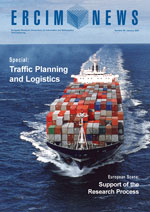by Marc Thiriet
The first Workshop on Multidisciplinary Simulation in Biomedical Applications was held in cooperation with ERCIM Working Group 'IT and Mathematics applied to Interventional Medicine' (IM2IM) at Berufsakademie (University for Cooperative Education), Mosbach, Germany from 21-22 November 2006.
The focus of the workshop was on multiphysics simulation, ie the use of different solvers, particularly coupled simulation methods mainly using MpCCI (Mesh-based parallel Code Coupling Interface), developed by the Fraunhofer SCAI team. MpCCI is the common feature of most of the work presented during the workshop:
-
Gerhard Link, Sensor Technology, University of Erlangen, gave a talk on substitute voice by the pharyngeal-esophageal segment (PES) and the effect of geometry on voice quality.
-
Christoph Müller, CADFEM GmbH - Ansys, presented a "patient-individual dental implant simulation", after briefly giving other simulation examples (spine column, bone implant planning, computation of muscle forces during body motions, gait analysis, surgery planning such as jaw remodelling, and forced extension of palate).
-
JG Schmidt, NEC Research Lab, St Augustin, spoke on "integrated biomedical informatics for the management of cerebral aneurisms". The multi-centre study involving many academic and industrial partners and supported by the EU is aimed at combining data (genetics, morphodynamics, etc.) for rupture risk assessment.
-
Andreas Burblies, Fraunhofer IFAM, Bremen, spoke on "material design for medical applications", the main application being the orthopedic field. The common goals are weight reduction and structure optimization using hybrid multiphase structures.
-
Johannes Meenen, Abaqus GmbH, gave a presentation on stenting and drug delivery from coated stents. Abaqus contains a standard implicit solver, suitable for slow mass transfer and also used to solve fluid-structure interaction, and an explicit dynamic solver, used when discontinuities occur (contact etc), especially for stent expansion and catheter retraction.
-
Ralf Kröger, Ansys/Fluent, talked on microfluidics, focusing on neutral hydrodynamics (as opposed to electrohydrodynamics). Illustrations on surface tension effects were given, as well as on droplet production.
-
Friedhelm Schönfeld, Institut für Microtechnik, Mainz, talked on biomicrofluidics (surface-tension-driven liquid flows which involve new physics, rarefied gas dynamics, etc) and the development of a modular chip-based lab platform.
-
Jürgen Berieter-Hahn, Institut für Zellbiologie und Neurowissenschaft, Center of BioMedical Engineering (CBME), Frankfurt am Main, introduced the CBME. Decubitus, aneurisms and stent design are the main targets of research in CBME.
-
Klaus Wolf, Fraunhofer SCAI, focused his talk on code coupling, using the neutral open interface MpCCI tool. It treats FSI, aeroacoustics, magnetohydrodynamics etc.
-
Marc Thiriet, INRIA, presented numerical results in image-based models of physiological flows. He demonstrated how helpful computational results can be in medical practice. He also pointed out the main drawbacks of the methodology, leading to qualification rather than quantification. He then talked about modelling strategies, and the ancient version of 'reductionism' leading to modern 'integrative approaches' of complex physiological systems.
A half-day session meeting was devoted to the 7FP, in order to define a proposal skeleton for ICT second calls in 2007.
Please contact:
Marc Thiriet
INRIA, France
ERCIM IM2IM Working Group coordinator
E-mail: marc.thiriet![]() ercim.org
ercim.org









